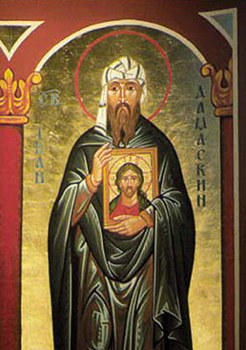John of Damascus, Treatises on the Divine Images - Discussion Guide

From my lips in their defilement,
From my heart in its beguilement,
From my tongue which speaks not fair,
From my soul stained everywhere,
O my Jesus, take my prayer!
Spurn me not for all it says,
Not for words and not for ways,
Not for shamelessness endued!
Make me brave to speak my mood,
O my Jesus, as I would!
Or teach me, which I rather seek,
What to do and what to speak.
--from John of Damascus, Anacreontic Hymn
Treatise 1
-
What are John's motivations for writing? How does he describe the state of the Church?
-
How does he purify his motives through prayer?
-
How does he answer the charges of the iconoclastic position based on the Old Testament? Do you find his exegesis convincing? Why or why not?
-
How does he distinguish veneration for worship and veneration for honor?
-
Why does he take the time to distinguish various kinds of images? (sec. 9-13)
-
How does John conceive of matter's role in salvation?
-
Why is the hypostatic union of Christ central to his argument?
-
How does he defend images of the saints?
-
What theology undergirds this defense? (cf. sec. 21)
-
What are some of the more important commentaries he makes on the florilegia following section 23?
-
According to John, why are the body and the senses important to receiving grace?
-
How does he refute the emperor's involvement with the controversy? (sec. 66)
John of Damascus' Morphology of Images
-
The Son as the Cosubstantial Image of the Father
-
The Eternal Archetypes in the Mind of God
-
Visible Symbols of Invisible Things (Creation), including Scripture
-
Typological Images of What Are to Come
-
Words and Images of Past Things to Be Remembered (e.g. Icons)
-
Human Beings as the Images of God
Exploratory Questions
- Do visual images have a role in public worship?
- Do they have a role in private prayer?
- Can one make a picture of God? of Christ? of the Trinity?
- Can one venerate an object, picture, or person without the worship reserved for God? Explain.
- What should our attitude be toward the saints who have gone before us?
- How important is the body to Christian spirituality?
- How important is it to Christian salvation?
- What is the relationship between Christian tradition and belief?
- If you were going to develop a theology of the arts, what elements would need to be included?
Treatise 3 (sec. 1-41) Assignment
For next class, you will be assigned a debating team. One group will defend the proposition, "John of Damascus offers a biblically and theologically convincing defense of icons." The other group will call this proposition into question. You should muster your evidence in the following manner:
- Locate important passages in treatise 1 and treatise 3.1-41. (You may also draw from treatise 2 or from 3.42ff., though it is not required.)
- Draw from the insights of others as discussed in "Early Christian Theology and the Iconoclastic Controversy" handout.
- Your own biblical exegesis and theological tradition or other traditions as you see fit.
- You should attempt to anticipate the other side's claims and evidence and be prepared to answer them.
Keep in mind that you may have to defend a position for the debate that you don't entirely agree with. Treat it as a learning exercise. At the end, we will drop the positions and share as to what we each find most convincing.
